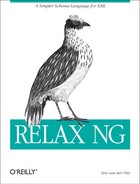Extensible and Open?
I wrote in the
introduction to this chapter that the
notions of “extensible” and
“open” are largely independent.
After all you have seen, you might even think that opening a schema
can be an impediment to its extensibility. Let’s say
I have written an open model for the content of the
book element that allows foreign nodes:
<define name="book-content">
<interleave>
<attribute name="id"/>
<attribute name="available"/>
<element name="isbn">
<ref name="isbn-content"/>
</element>
<element name="title">
<ref name="title-content"/>
</element>
<zeroOrMore>
<element name="author">
<ref name="author-content"/>
</element>
</zeroOrMore>
<zeroOrMore>
<element name="character">
<ref name="character-content"/>
</element>
</zeroOrMore>
<ref name="foreign-nodes"/>
</interleave>
</define>or:
book-content =
attribute id { text }
& attribute available { text }
& element isbn { isbn-content }
& element title { title-content }
& element author { author-content }*
& element character { character-content }*
& foreign-nodesI have independently applied the tips for building an extensible
schema (using interleave and containers) and also
for defining an open schema (referencing a wildcard to allow foreign
nodes). Unfortunately, if my schema is open, it’s no
longer very extensible.
Imagine that I want to add a couple of XLink attributes to define a
link to a web page. I can’t combine this new
attribute with the existing schema using
interleave. This new attribute would be considered
a duplicate of the implicit definition of
xlink:href already contained in the
foreign-nodes wildcard.
The situation is similar for the addition of new elements. If I want
to add an optional
dc:copyright
element, for instance, I can, but the
constraint applied to this element will be in conflict with the lax
definition of dc:copyright implicitly contained in
the foreign-nodes wildcard. If the new constraint
isn’t met, RELAX NG will still find a match for a
bogus dc:copyright element in the wildcard.
Does that mean that open schemas can’t be extensible? Yes and no. While wildcards make open schemas less extensible, I can overcome that problem by extending schemas before opening them. To come back to the example, I’d better write a closed schema first (closed-schema.rng ):
<define name="book-content">
<interleave>
<attribute name="id"/>
<attribute name="available"/>
<element name="isbn">
<ref name="isbn-content"/>
</element>
<element name="title">
<ref name="title-content"/>
</element>
<zeroOrMore>
<element name="author">
<ref name="author-content"/>
</element>
</zeroOrMore>
<zeroOrMore>
<element name="character">
<ref name="character-content"/>
</element>
</zeroOrMore>
</interleave>
</define>or, in the compact syntax, closed-schema.rnc :
book-content =
attribute id { text }
& attribute available { text }
& element isbn { isbn-content }
& element title { title-content }
& element author { author-content }*
& element character { character-content }*I can then carefully keep this closed schema in a first document and extend it by inclusion and combination to become open:
<include href="closed-schema.rng"/>
<define name="book-content" combine="interleave">
<ref name="foreign-nodes"/>
</define>or:
include "closed-schema.rnc" book-content &= foreign-nodes
Applications would then use the open schema (the one produced by
inclusion and combination) and derive the benefit as if the schema
were natively open. The closed-schema would be available to extend
the content model, redefine the foreign-node
wildcard, and open the schema again in different ways.
